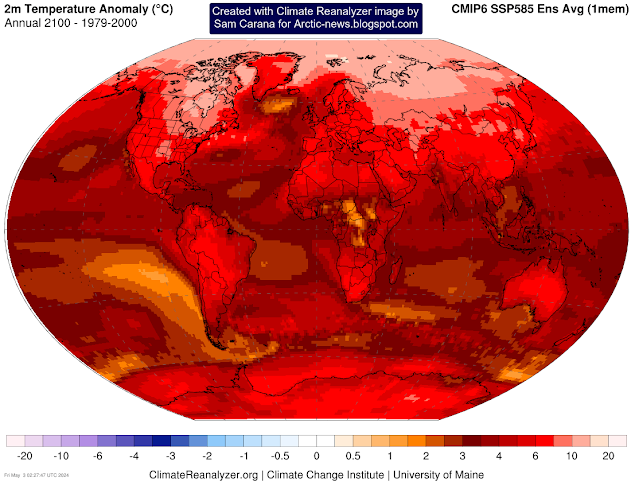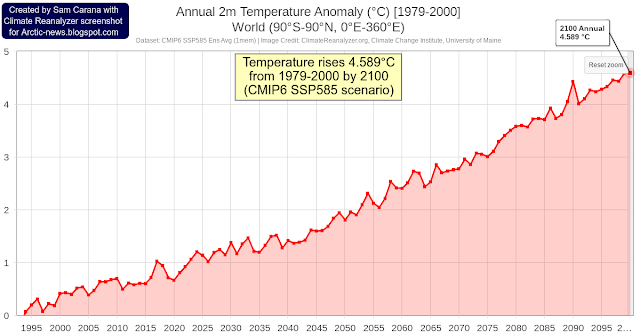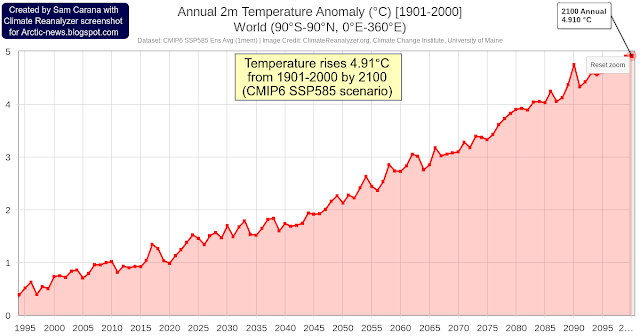The image below, adapted from Climate Reanalyzer, shows the temperature in the year 2100, in a CMIP6 SSP585 scenario. The image shows how much the temperature will have risen in 2100, at 2 meters above the surface and compared to the period 1979-2000.
The image below shows a progressive temperature rise reaching 4.589°C in 2100 compared to the same period, i.e. 1979-2000 and in a CMIP6 SSP585 scenario.
The 1979-2000 period is relatively recent. The temperature has been rising for longer than that. The image below shows a progressive temperature rise reaching 4.91°C by 2100 in a CMIP6 SSP585 scenario when instead using a 1901-2000 period as a base.
The 1901-2000 period is also relatively recent, much later than pre-industrial. When using a pre-industrial base, the temperature rise will be well over 5°C.
As illustrated by the top image, the temperature rise over land will be much higher than over oceans, which makes the situation even more dire, given that most people live on land and could face a rise of 8°C by 2100 in a CMIP6 SSP585 scenario.
In a CMIP6 SSP585 scenario, temperatures are projected to keep rising strongly beyond 2100, as illustrated by the image below, from a 2016 paper by Brian O’Neill et al.
In other words, CO₂ may well be rising even faster than anticipated in a CMIP6 SSP585 scenario, while this scenario doesn’t take into account the potential for CO₂e concentrations to cross 1200 ppm much earlier than 2100 (inset), e.g. before 2060 as illustrated by the red trend in the main image. Furthermore, CMIP6 SSP585 doesn’t take into account that, in addition to the temperature rise resulting from high greenhouse gas concentrations, crossing the clouds tipping point at 1200 ppm in itself would push up temperatures by a further 8°C.
Indeed, the clouds tipping point could be crossed even earlier when also taking into account methane, nitrous oxide and further greenhouse gases, while there are additional developments such as organic carbon and inorganic carbon release from soils that could further raise both CO₂ concentrations and temperatures. The Extinction page and posts such as this one and this one warn about the potential for a temperature rise of well over 18°C unfolding as early as 2026.
In conclusion, the temperature looks set to be rising higher and faster at accelerating rate, dwarfing anything seen in previous extinction events, as illustrated by the image below, from an earlier post.
The above image is a screenshot from the video (further above) in which physicist J. Robert Oppenheimer reflects on the first test of the atomic bomb. His haunting words mark the moment when science met conscience.
Similarly, climate change is a destroyer of worlds with unfathomable consequences, yet politicians refuse to heed the warnings, in an unprecedented breach of moral values, neglect of the precautionary principle, betrayal of trust and violation of the duty of care.
As a result, the IPCC persists with downplaying the potential for dangerous developments in efforts to hide the need for the most effective climate action. The IPCC keeps pointing at less effective policies such as support for BECCS and biofuel, while continuing to make it look as if there was a carbon budget to divide among polluters, as if polluters could continue to pollute for decades to come, as discussed in earlier posts such as this one.
Meanwhile, a 2018 study (by Strona & Bradshaw) indicates that most life on Earth will disappear with a 5°C rise. Humans, who depend for their survival on many other species, will likely go extinct with a 3°C rise, as illustrated by the image below, from an earlier post.
Climate Emergency Declaration
The situation is dire and the precautionary principle calls for rapid, comprehensive and effective action to reduce the damage and to improve the situation, as described in this 2022 post, where needed in combination with a Climate Emergency Declaration, as discussed at this group.
Links
• Climate Reanalyzer
https://climatereanalyzer.org
• The Scenario Model Intercomparison Project (ScenarioMIP) for CMIP6 – by Brian O’Neill et al. (2016)
https://www.iea.org/reports/co2-emissions-in-2023
• September 2023, highest anomaly on record?
• CO2 keeps accelerating
https://arctic-news.blogspot.com/2024/04/co2-keeps-accelerating.html
• Feedbacks in the Arctic
https://arctic-news.blogspot.com/p/feedbacks.html
• Pre-industrial
https://arctic-news.blogspot.com/p/pre-industrial.html
• Clouds Feedback and the Clouds Tipping Point
https://arctic-news.blogspot.com/p/clouds-feedback.html
• The Threat
https://arctic-news.blogspot.com/p/threat.html
• Amplifying feedback loop between drought, soil desiccation cracking, and greenhouse gas emissions – by Farshid Vahedifard et al.
discussed on facebook at
https://www.facebook.com/groups/arcticnews/posts/10161298567849679
• Size, distribution, and vulnerability of the global soil inorganic carbon – by Yuanyuan Huang et al. https://www.science.org/doi/10.1126/science.adi7918
discussed at facebook at
https://www.facebook.com/groups/arcticnews/posts/10161354439024679
• Extinction
https://arctic-news.blogspot.com/p/extinction.html
• When will humans go extinct?
https://arctic-news.blogspot.com/2022/02/when-will-humans-go-extinct.html
• Shortcomings of IPCC AR6 WGIII – Mitigation of Climate Change
https://arctic-news.blogspot.com/2022/04/shortcomings-of-ipcc-ar6-wgiii-mitigation-of-climate-change.html
• Transforming Society
• Climate Plan
https://arctic-news.blogspot.com/p/climateplan.html
• Climate Emergency Declaration
https://arctic-news.blogspot.com/p/climate-emergency-declaration.html




.png)





